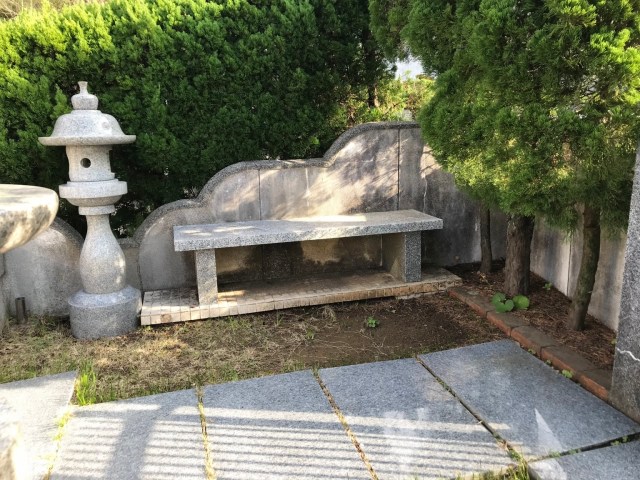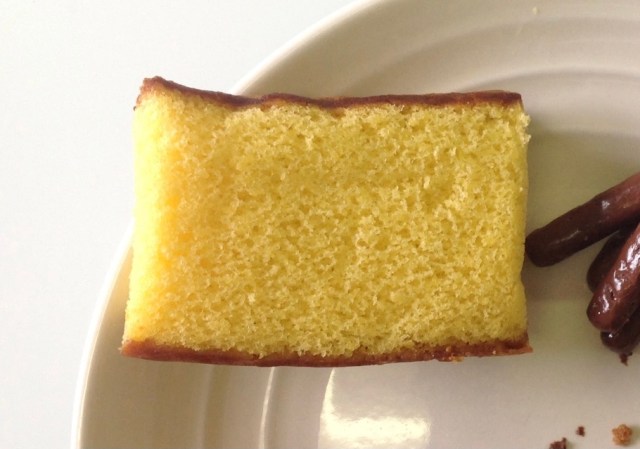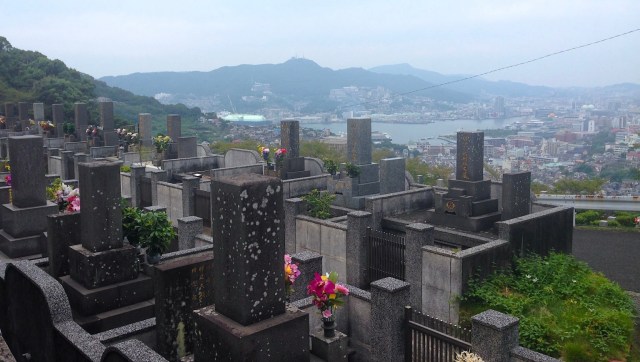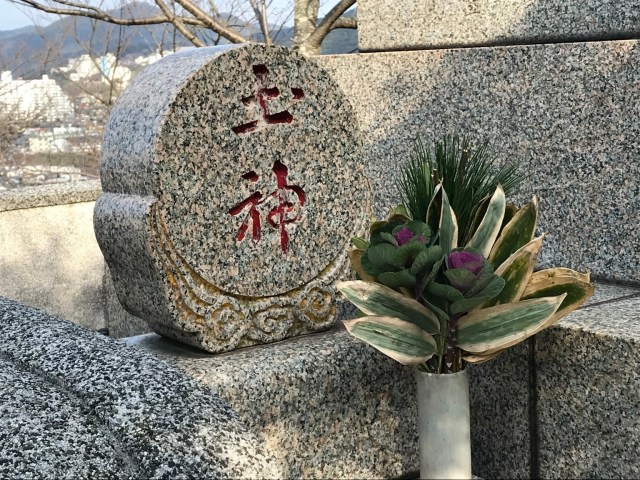
When your feet are killing you, rest in peace at the cemetery!
Particularly for people coming to Japan from other countries, one common gripe is the severe lack of outdoor seating such as benches. However, there is one place where such seating is surprisingly ample —Nagasaki cemeteries!
Taking a stroll through any graveyard in Nagasaki Prefecture, you’re likely to find a lot of benches, stools, and tables scattered among the monuments marking family graves.
However, before those of you in other parts of Japan start packing a picnic basket and polishing a talisman, bear in mind that this is a feature unique to Nagasaki only.
Nagasaki is a historically unique part of Japan. While the country remained closed off for centuries under the rule of the Tokugawa shogunate (1639-1854), Nagasaki was an exception in which trade between foreign countries was tolerated. As a result it was exposed to cultural influences not seen elsewhere.
▼ Japanese castella cake, which was imported from Europe, originated in Nagasaki.
One Nagasaki custom that likely came from China, was the act of setting off fireworks in cemeteries. This combined with the Japanese holiday season of Obon in August, when the spirits of deceased ancestors are said to return to the realm of the living. It was fortunate for Nagasaki people who didn’t need to worry about waking the dead with their festive explosives, because they were already up.
▼ Nagasaki in general has an above-average affinity for fireworks
Obon customs vary from region to region in Japan but for the most part, families gather at graves, wash them, pray, and give offerings such as a One Cup of sake. In Nagasaki, however, families also shoot off some bottle rockets and have a meal while among the dead, so it’s very practical to have some seating there as well.
It’s such a common habit in the southern prefecture that you’ll probably find most graveyards are located on hillsides for the ideal firework-shooting views.
Our Japanese-language writer Mariko Ohanabatake, who hails from Nagasaki, was surprised to find that her annual custom was unheard of elsewhere in Japan, even in her neighboring prefectures. Since visiting graves are solely family affairs that involve returning to hometowns, people rarely see the customs of other areas, keeping them relatively insulated to their respective regions.
That’s not the only thing unique to Nagasaki cemeteries either. Unlike other parts of Japan, graves here are usually engraved with gold lettering.
Nagasaki family graves also tend to have smaller monuments honoring the “earth god” next to the main monument. Both of these features are believed to have come from Chinese culture as well.
You’re likely to find unique touches to Obon anywhere you go in Japan, but in general, if you want to see a slightly different side of Japanese culture, there’s a whole lot to discover in Nagasaki.
Photos: ©SoraNews24
● Want to hear about SoraNews24’s latest articles as soon as they’re published? Follow us on Facebook and Twitter!
[ Read in Japanese ]






 Take it from a local: This resort island off the coast of Nagasaki is totally worth a side trip
Take it from a local: This resort island off the coast of Nagasaki is totally worth a side trip Cruising around Gunkanjima, Japan’s otherworldly “Battleship Island”【Photos】
Cruising around Gunkanjima, Japan’s otherworldly “Battleship Island”【Photos】 These are the hidden-gem catspotting neighborhoods of Nagasaki【Photos】
These are the hidden-gem catspotting neighborhoods of Nagasaki【Photos】 Japanese taxi company offers service to visit family graves for those who can’t travel themselves
Japanese taxi company offers service to visit family graves for those who can’t travel themselves There’s only one place in Japan where this kind of sushi isn’t red, but why?
There’s only one place in Japan where this kind of sushi isn’t red, but why? Foreigner’s request for help in Tokyo makes us sad for the state of society
Foreigner’s request for help in Tokyo makes us sad for the state of society Japanese city loses residents’ personal data, which was on paper being transported on a windy day
Japanese city loses residents’ personal data, which was on paper being transported on a windy day Harajuku Station’s beautiful old wooden building is set to return, with a new complex around it
Harajuku Station’s beautiful old wooden building is set to return, with a new complex around it Ghibli Park now selling “Grilled Frogs” from food cart in Valley of Witches
Ghibli Park now selling “Grilled Frogs” from food cart in Valley of Witches Akihabara pop-up shop sells goods made by Japanese prison inmates
Akihabara pop-up shop sells goods made by Japanese prison inmates Anime girl English teacher Ellen-sensei becomes VTuber/VVTUber and NFT
Anime girl English teacher Ellen-sensei becomes VTuber/VVTUber and NFT Starbucks Japan releases new mugs and gifts for Mother’s Day
Starbucks Japan releases new mugs and gifts for Mother’s Day We tried Korea’s way-too-big King Tonkatsu Burger at Lotteria 【Taste Test】
We tried Korea’s way-too-big King Tonkatsu Burger at Lotteria 【Taste Test】 Mt. Koya planning to instate visitor’s tax to cope with huge tourist numbers
Mt. Koya planning to instate visitor’s tax to cope with huge tourist numbers You Can Have Your Very Own Whale Party on iPhone Messages In Just a Few Simple Steps
You Can Have Your Very Own Whale Party on iPhone Messages In Just a Few Simple Steps McDonald’s new Happy Meals offer up cute and practical Sanrio lifestyle goods
McDonald’s new Happy Meals offer up cute and practical Sanrio lifestyle goods Japanese ramen restaurants under pressure from new yen banknotes
Japanese ramen restaurants under pressure from new yen banknotes All-you-can-drink Starbucks and amazing views part of Tokyo’s new 170 meter-high sky lounge
All-you-can-drink Starbucks and amazing views part of Tokyo’s new 170 meter-high sky lounge French Fries Bread in Tokyo’s Shibuya becomes a hit on social media
French Fries Bread in Tokyo’s Shibuya becomes a hit on social media Studio Ghibli releases new action figures featuring Nausicaä of the Valley of the Wind characters
Studio Ghibli releases new action figures featuring Nausicaä of the Valley of the Wind characters New private rooms on Tokaido Shinkansen change the way we travel from Tokyo to Kyoto
New private rooms on Tokaido Shinkansen change the way we travel from Tokyo to Kyoto Red light district sushi restaurant in Tokyo shows us just how wrong we were about it
Red light district sushi restaurant in Tokyo shows us just how wrong we were about it Studio Ghibli glasses cases let anime characters keep an eye on your spectacles
Studio Ghibli glasses cases let anime characters keep an eye on your spectacles Tokyo Tsukiji fish market site to be redeveloped with 50,000-seat stadium, hotel, shopping center
Tokyo Tsukiji fish market site to be redeveloped with 50,000-seat stadium, hotel, shopping center Beautiful Ghibli sealing wax kits let you create accessories and elegant letter decorations【Pics】
Beautiful Ghibli sealing wax kits let you create accessories and elegant letter decorations【Pics】 Studio Ghibli releases Kiki’s Delivery Service chocolate cake pouches in Japan
Studio Ghibli releases Kiki’s Delivery Service chocolate cake pouches in Japan New definition of “Japanese whiskey” goes into effect to prevent fakes from fooling overseas buyers
New definition of “Japanese whiskey” goes into effect to prevent fakes from fooling overseas buyers Our Japanese reporter visits Costco in the U.S., finds super American and very Japanese things
Our Japanese reporter visits Costco in the U.S., finds super American and very Japanese things Studio Ghibli unveils Mother’s Day gift set that captures the love in My Neighbour Totoro
Studio Ghibli unveils Mother’s Day gift set that captures the love in My Neighbour Totoro New Japanese KitKat flavour stars Sanrio characters, including Hello Kitty
New Japanese KitKat flavour stars Sanrio characters, including Hello Kitty More foreign tourists than ever before in history visited Japan last month
More foreign tourists than ever before in history visited Japan last month New Pokémon cakes let you eat your way through Pikachu and all the Eevee evolutions
New Pokémon cakes let you eat your way through Pikachu and all the Eevee evolutions Sales of Japan’s most convenient train ticket/shopping payment cards suspended indefinitely
Sales of Japan’s most convenient train ticket/shopping payment cards suspended indefinitely Sold-out Studio Ghibli desktop humidifiers are back so Totoro can help you through the dry season
Sold-out Studio Ghibli desktop humidifiers are back so Totoro can help you through the dry season Japanese government to make first change to romanization spelling rules since the 1950s
Japanese government to make first change to romanization spelling rules since the 1950s Ghibli founders Toshio Suzuki and Hayao Miyazaki contribute to Japanese whisky Totoro label design
Ghibli founders Toshio Suzuki and Hayao Miyazaki contribute to Japanese whisky Totoro label design Doraemon found buried at sea as scene from 1993 anime becomes real life【Photos】
Doraemon found buried at sea as scene from 1993 anime becomes real life【Photos】 Tokyo’s most famous Starbucks is closed
Tokyo’s most famous Starbucks is closed One Piece characters’ nationalities revealed, but fans have mixed opinions
One Piece characters’ nationalities revealed, but fans have mixed opinions We asked a Uniqlo employee what four things we should buy and their suggestions didn’t disappoint
We asked a Uniqlo employee what four things we should buy and their suggestions didn’t disappoint Princesses, fruits, and blacksmiths: Study reveals the 30 most unusual family names in Japan
Princesses, fruits, and blacksmiths: Study reveals the 30 most unusual family names in Japan Koikeya giving snackers a chance to compare chips made from potatoes in 3 Japanese regions
Koikeya giving snackers a chance to compare chips made from potatoes in 3 Japanese regions Go to hell: Unzen Hot Springs invites visitors to take an infernal stroll through a field of deadly hell-mouths
Go to hell: Unzen Hot Springs invites visitors to take an infernal stroll through a field of deadly hell-mouths Nagasaki Lantern Festival: An awesome event that will whisk you away into a celestial world【Pics】
Nagasaki Lantern Festival: An awesome event that will whisk you away into a celestial world【Pics】 Here’s a little tip from a Buddhist monk for anyone spooked by cemeteries at night
Here’s a little tip from a Buddhist monk for anyone spooked by cemeteries at night Japanese city changes into beautiful Spirited Away lookalike once a year, and it’s happening now
Japanese city changes into beautiful Spirited Away lookalike once a year, and it’s happening now Survey asks Japanese people where they’d most like to “live” after death
Survey asks Japanese people where they’d most like to “live” after death Starbucks Japan joins Been There drinkware line with 20 cool designs for all over Japan【Pics】
Starbucks Japan joins Been There drinkware line with 20 cool designs for all over Japan【Pics】 New Shinkansen bullet train design revealed for Nagasaki extension
New Shinkansen bullet train design revealed for Nagasaki extension Power up with this positively scrumptious kakuni braised pork Pac-Man manju from Nagasaki
Power up with this positively scrumptious kakuni braised pork Pac-Man manju from Nagasaki Starbucks’ cool new Japan Geography tumblers will take you on a trip around the country
Starbucks’ cool new Japan Geography tumblers will take you on a trip around the country Japanese travel agency reveals summer 2022’s most popular destinations domestically and abroad
Japanese travel agency reveals summer 2022’s most popular destinations domestically and abroad It’s pretty amazing buses in this Japanese town don’t crash into this mountain every day【Video】
It’s pretty amazing buses in this Japanese town don’t crash into this mountain every day【Video】 Castella cake ice cream debuts in Japan, and it’s one of the strangest things we’ve ever tasted
Castella cake ice cream debuts in Japan, and it’s one of the strangest things we’ve ever tasted Nagasaki Starbucks marks anniversary of World War II’s end with powerful message of peace
Nagasaki Starbucks marks anniversary of World War II’s end with powerful message of peace First-ever Bon-Odori dance festival to be held at Shibuya scramble crossing for Obon
First-ever Bon-Odori dance festival to be held at Shibuya scramble crossing for Obon
Leave a Reply